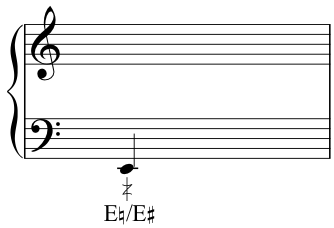Pedal buzz
Production
A pedal buzz is produced by holding the pedal halfway between two pedal positions. Therefore, as it is played, the string vibrates against the metal of the tuning disc. It is possible to hold the pedal in half position before playing the string, to produce an immediate buzz, or to move the pedal into the half position after the string has been played. A pedal buzz can be produced quite a while after the string was played.This is especially valid for the strings in the low register. (See: Sound duration/decay).
Sound
A pedal buzz is a metallic buzzing sound. The metallic sound is more extreme in the low register where the wire strings are made from metal. The low strings also have a longer resonating time and therefore the buzz sounds longer.
Notation
The standard symbol for a pedal buzz is the noise symbol placed between the two pedal settings in question.

Noise symbol.

Pedal buzz notation.
Although the pedal is moved halfway, the pitch of the string does not change. See: additional remarks here below.
Range
Pedal buzzes are possible on the whole harp, except in the top octave (aprox. g'''-g'''') where the effect is inaudible. Pedal buzzes are most effective in the low register.
Additional Remarks
Although the pedal is positioned halfway between two semitones this does not mean that the pitch of the string is a quarter-tone. Moving the pedal does not raise the pitch of the string gradually. When a pedal is moved the tuning disc turns and stops the string at an exact point and raises the pitch of the string instantly. By holding the pedal in half position the fork of the tuning disc is close to the string but has not engaged it yet. The sound of the string is dirty and buzzy, but the pitch stays the same.